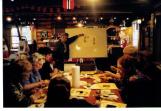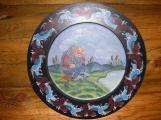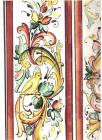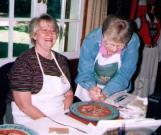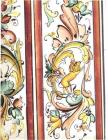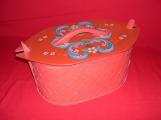1
Rosemaling - Demonstrated by Syneva2007
Heritage Square, Red Deer, Alberta
 Credits:
Credits:Julie Macrae, Videographer
Syneva Baltimore, Demonstrating Rosemaling Techniques
3
RosemalingRosemaling
"Norwegian Rosemaling is a colorful and distinctive folk art unique to and originating in Norway several centuries ago - an astonishingly sophisticated style of decorative painting on wood," says Marion John Nelson, Professor of Art History, University of Minnesota and Director, Norwegian-American Museum at Decorah, IA on December 14, 1972.
Rosemaling literally means rose painting and involves decorating wooden surfaces with graceful, colorful designs on unpainted or painted furniture, beds, chairs, benches, chests, cupboards, doors, shutters, bowls, trays, etc. This folk art has been researched, learned and practiced by a few hundred students over the past thirty years because of the Laft Hus and its programs.
The word rosemaling is used to describe a form of decorative flower painting that originated in Norway in the 1700s. These graceful designs are derived from C and S strokes and are characterized by flowing lines and scroll, imaginative, fanciful flowers, and subtle colors. Rosemaling may also incorporate figures, scenes and script lettering.
Several different styles of rosemaling exist, each named for the region in which it originated. The most common styles seen today are Telemark, Hallingdal and Rogaland."
"Rosemaling, an art form over 1000 years old, was copied by the roving Vikings in the 9th century from the Greek and Roman acanthus leaf. They used carve this leaf on their ships as decoration and protection from evil happenings. This is one of the earliest Rosemaling forms known. Today's Rosemaling continues the characteristically complex curving and interfacing of the organic decorations of the Viking Age. Today, the three prominent Rosemaling styles are Hallingdal, Rogaland and Telemark. With the loss of the original Master Rosemalers in Norway, there is a lack of good sources of instructions in the homeland of this beautiful art. There are no major teaching institutions available anymore. Several decades ago there used to be a Rosemaling School in a place called Sand in the southern part of Norway. But there are no major educational institutions available anymore or proper places to display art work, except for limited space in a few museums. The Norwegian authorities are! not supporting Rosemaling as they do with other art forms.
The US has become the adopted homeland of Rosemaling. This started with the mass immigration from Norway in the second quarter of the nineteenth century when also many Rosemalers moved to the New World. Much credit for this growing popularity must also be given to the great Vesterheim Norwegian-American museum in Decorah, Iowa. This is the US cultural center for priceless Norwegian art and heirlooms from the days of the first emigrants and up to modern times. One of the favorite objects of Rosemaling in Norway was the storage trunk. This piece of furniture became the standard luggage of the immigrants. As a consequence, examples of Rosemaling came to America in an even greater numbers than the painters who produced this art. In the past, the connection between Rosemaling and America was largely due to historical circumstances. Today, a much more significant relationship is being established. The revival began with the immigrant groups, but soon attracted the attention of the broader American public. Rosemaling is now found in adult education programs and arts and crafts businesses all over the country. There are now many more Rosemalers in the US than in Norway!"
Credits:
Betty Wulff, Author
7
Sylvia Jones demonstrating Rosemaling designs1990's - 2000's
Red Deer, Alberta, Canada
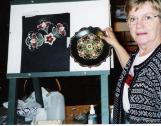 Credits:
Credits:Norwegian Laft Hus Society
9
"Kong Chair" - Child's Chair built by Cliff Hanson and Rosemaled by Susan Judge or Red Deer, Alberta1990's
Red Deer, Alberta, Canada
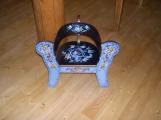 Credits:
Credits:Cliff Hanson - built chair; Red Deer,AB
Susan Judge - rosemaled chair; Red Deer, AB
10
Public Programming - Arts & Crafts - Rosemaling - Children's Class at Norwegian Laft HusRed Deer, Alberta, Canada
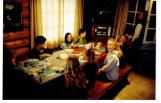
11
Public Programming - Arts & Crafts - Rosemaling Class2006
Red Deer, Alberta, Canada
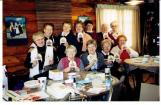 Credits:
Credits:Norwegian Laft Hus Society
12
Arts & Crafts - Rosemaling Class with Art on Display2000's
Heritage Square, Red Deer, Alberta
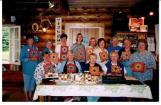 Credits:
Credits:Norwegian Laft Hus Society
back row: Ruth Campbell, Sylvia Jones, Karen Westly, Margaret Brookwell, Betty Cox, Sharon Johnson, Linda Nelson & Betty Wulff
(bottom row L to R) Karen Barnabe, Joyce Nordstrom, Lois Mueller (instructor) and Julie Macrae
13
Arts & Crafts - Rosemaling - Sylvia Jones and Anna Kaastrup work on Rosemaling detailed artworkRed Deer, Alberta, Canada
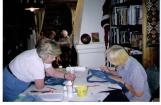 Credits:
Credits:Sylvia Jones
Anna Kaastrup
14
Arts & Crafts - Rosemaling - Sylvia Jones intstructs rosemaling class at Laft HusRed Deer, Alberta, Canada
